This report details our recent survey findings so you’ll know what your peers are doing, why, and how.
Project management software as a category has evolved to encompass a range of products, from team-centric work management tools to enterprise-level portfolio management solutions.
This is both a benefit and a challenge for users.
With hundreds of tools to choose from, it’s almost guaranteed there’s a tool out there that can meet your needs. At the same time, there are hundreds of tools to choose from.
Having that many options makes it difficult to know where to start searching for software. And it makes it that much easier to make a bad investment and wind up paying for features you won’t use, or worse yet, paying for an entire tool your team won’t use.
Luckily, knowing how your peers have invested in project management (PM) software can help you replicate their successes and avoid their mistakes, ultimately saving you time and money.
That’s why, in our Project Management User Survey*, we surveyed hundreds of your peers to find out who is using project management software or manual tools, the features they use, don’t use, which ones they wish they had used, and what results they’ve seen from their investment.
This article is a question-and-answer style market research report that you can pull from to create a business case for a new project management software tool for your business.
/ Key takeaways
Functionality continues to be the most important factor in project management software purchase decisions with price being second. However, ease of use has returned as users’ third biggest concern (surpassing customer service).
It’s clear that users’ cost-consciousness plays a key role in purchase decisions and the vast majority hit the mark on their budget, with no more than 3% missing their budgeted expenditure across the board.
People need PM tools, and they needed them yesterday: 63% of users spent less than six months choosing their PM software, and 61% spent less than six months implementing the software.
The basics such as reports/dashboards, document management, and team collaboration are the most-used PM tool features. But Gantt and burndown charts are surprisingly both in the most-ignored and most-desired PM software features.
What benefits are businesses getting out of using a PM tool?
Yes, great place to start! The most often reported benefit is that project managers are better able to accurately estimate a project’s timeline when using a project management tool (60%). The next most common benefit is the ability to use project resources more effectively (55%). This means PM tools are helping businesses to better schedule and assign project work.
Here’s a breakdown of the benefits reported:
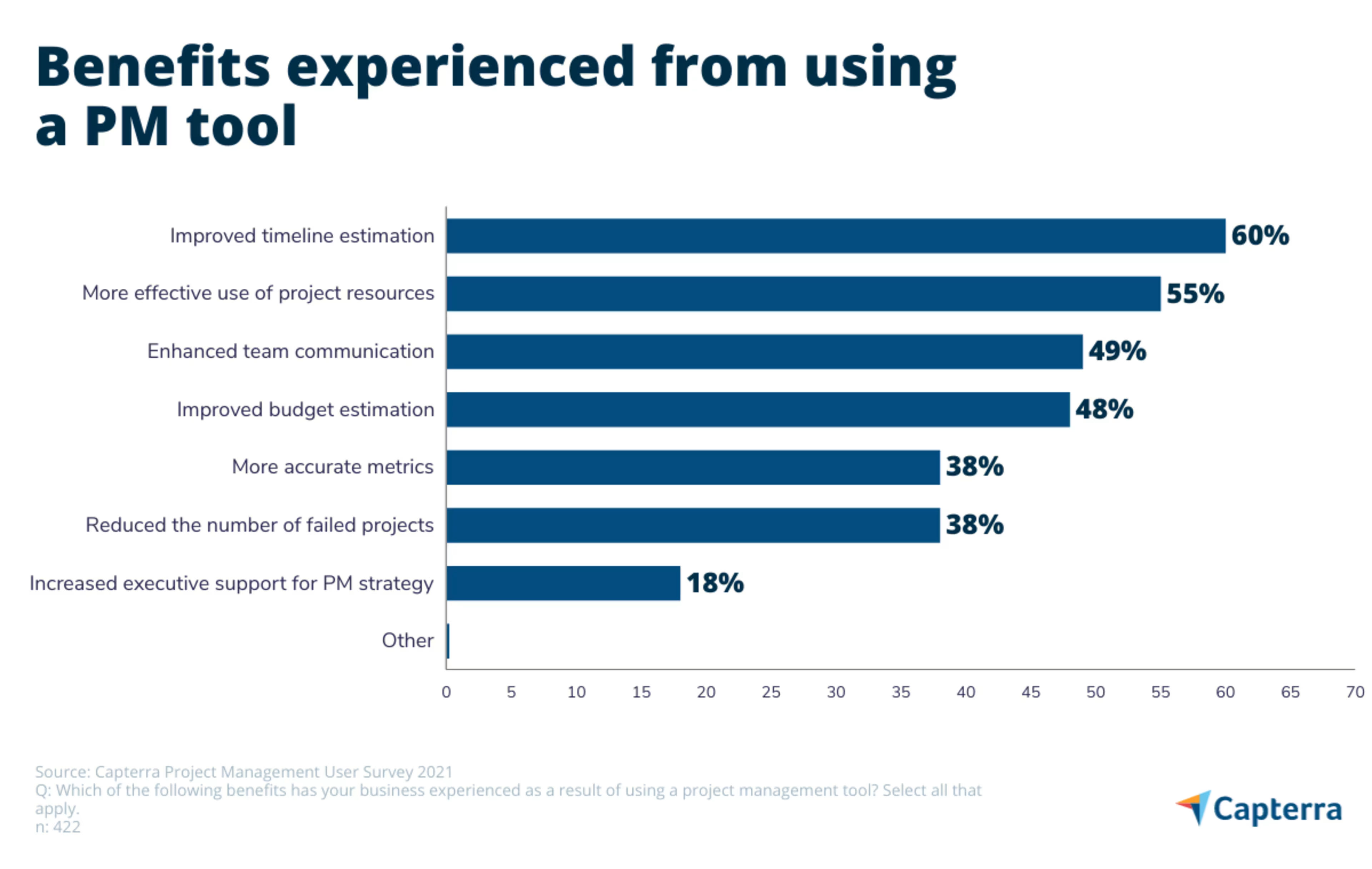
In this report, we’ll be covering all aspects of how businesses are using, not using, selecting, benefiting, and more.
Who uses project management software?
The short answer: Adoption is high for businesses in information technology (IT) services, banking/financial services, manufacturing, accounting, and construction industries across nearly every business size. Within an organization, project team members (55%) and dedicated PMs (27%) are the main users of the actual software.
We asked over 400 project managers what tools they use to manage projects in their organization. Here is how respondents’ demographics break down across who uses a PM tool versus manual methods by business size.
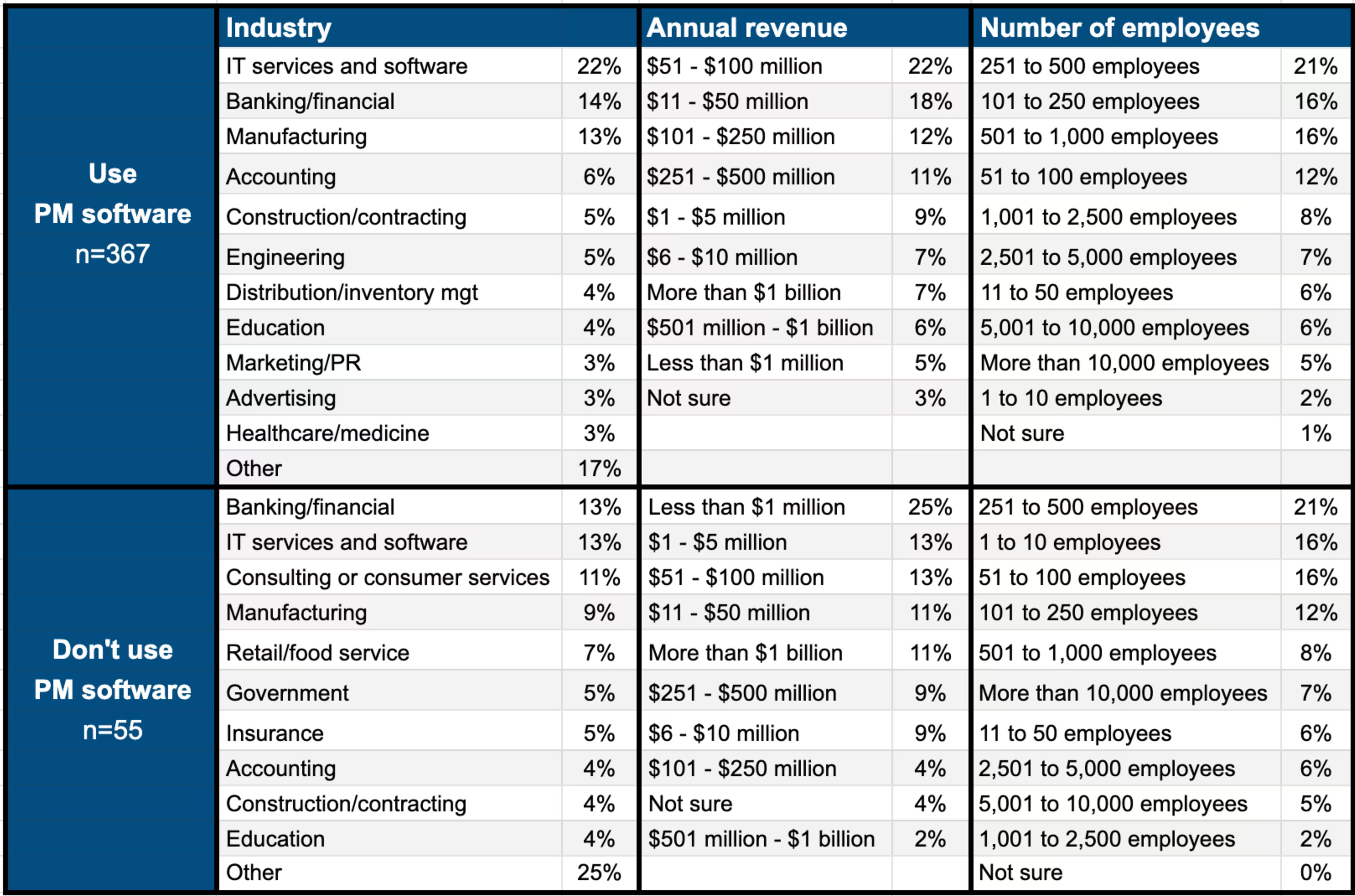
While PM software adoption is widespread across industries and businesses, regardless of size, it’s clear that the lack of adoption is highest among startups and very small businesses.
For example, 25% of small businesses, which generate less than $1 million in annual revenue, do not use PM software, compared to only 5% that do—16% of businesses with between one and ten employees do not use PM software, compared to only 2% that do.
This shows that while spreadsheets and manual methods are often the go-to tools for small teams and businesses, eventually their projects and processes become complex enough as the company gets larger to require automated tools.
PRO TIP: If you don’t currently use PM software, here are some warning signs that can signal that it’s time to invest in an automated solution:
Lack of visibility into task or project status
Inconsistent execution of processes
Siloed teams and information
Ineffective collaboration
Conversely, the consistent adoption of PM software among businesses of almost every size shows that this tech provides a clear return on investment (ROI) and a near universal benefit to organizations (benefits that we’ll cover in a later section).
What project management methodologies are my peers using?
Sure thing. Over half (51%) of respondents say they use Integrated Project Management (IPM) methods. IPM ensures projects are not managed in isolation and decisions made aren’t limited to the confines of traditional waterfall or even agile project management methods. It takes into account not only how aspects of your project relate to each other but also how other parts of the organization relate to your project.
The others are using a hybrid approach (21%), Agile (17%), waterfall (7%), and then PRINCE2 came in last at 5% of respondents using it.
How should companies choose project management software?
The short answer: PMs agree that functionality is the most important consideration when making a purchase decision, followed by price, ease of use, then customer support. However, prospective buyers aren’t taking advantage of product demos as much as they should be—just 29% demoed more than two products before making their final purchase decision.
Functionality continues to be the most important factor in choosing PM software, the same as it has been consistently since our 2015 PM software user reports.
In our 2019 findings, we saw a dip in the importance of ease of use but it has now been prioritized above customer support. Price is still a top concern, but the rise in software’s popularity shows that the marketing of a product is more important than ever. (We’ll dig into how users’ cost-consciousness plays into software purchases in the next section.)
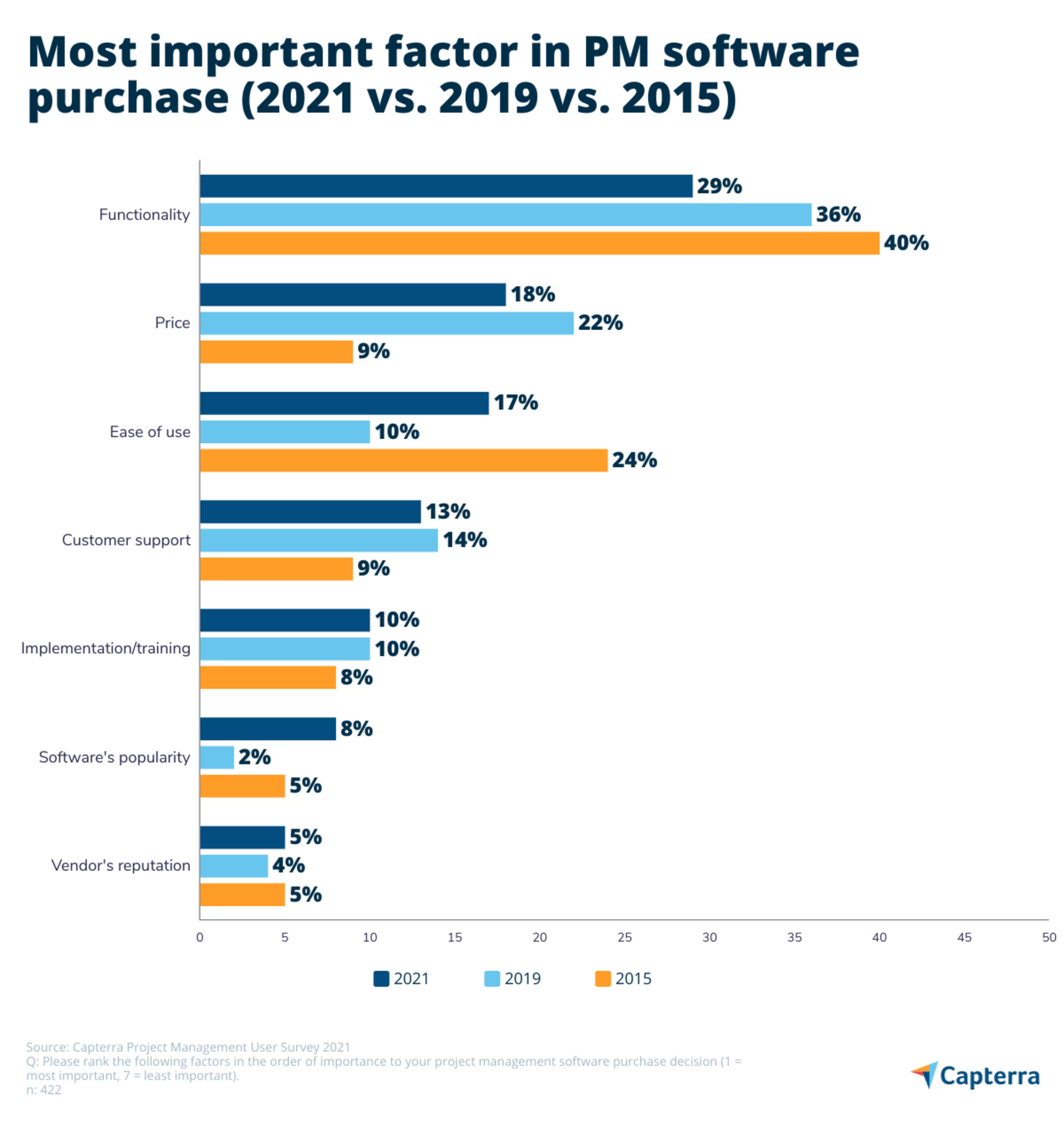
PRO TIP: Functionality is tied to user satisfaction. While the majority of users report high levels of satisfaction with their PM solution, for those who aren’t satisfied, the number one cited reason is that the software is missing necessary features.
Demos are a great way to try out a tool prior to making a purchase decision and can help you test its ease of use before you buy. Give vendors a description of how you need to use the tool in your day-to-day, then have them walk you through that process during the demonstration—and make sure that at least one key end user is on the call to give feedback on the tool’s functionality.
Why the importance on functionality? Asking for a friend
Well, tell your friend that functionality (or rather, the lack of the right functionality) is the main pain point cited (at 39%) among users who are dissatisfied with their current PM tool.
This is why it’s so essential that you evaluate the needs of your users prior to even starting your software search, so you can identify what your must-have features are compared to the nice-to-have features. Breaking functionality down in this way will help you vet prospective products and make a final purchase decision.
Consider the following as you’re analyzing your needs:
Do you need a full-featured PM solution? Or are you looking for something targeted to task management or collaboration?
Do the key capabilities your team needs come “out of the box,” or do you require customizations or integrations such as adding issue tracking or ticketing for an IT team?
Do you have industry-specific needs that require a specialized solution? For example, PM software for construction projects versus a general purpose solution.
How many users need access to the system?
What deployment method are you looking for, cloud-based or installed on-premise?
Tell me more about software selection. What should I look out for?
Take full advantage of how eager sales people are to talk about their product with you by watching it in action with demos. And not just one or two products—you should vet at least three in action before making a decision.
We asked the 385 respondents who said they were directly involved in the PM software purchasing process how many products they demoed before making their final purchase decision, and the results were surprising: 61% demoed two or fewer solutions before buying their PM tool. This is a huge missed opportunity.
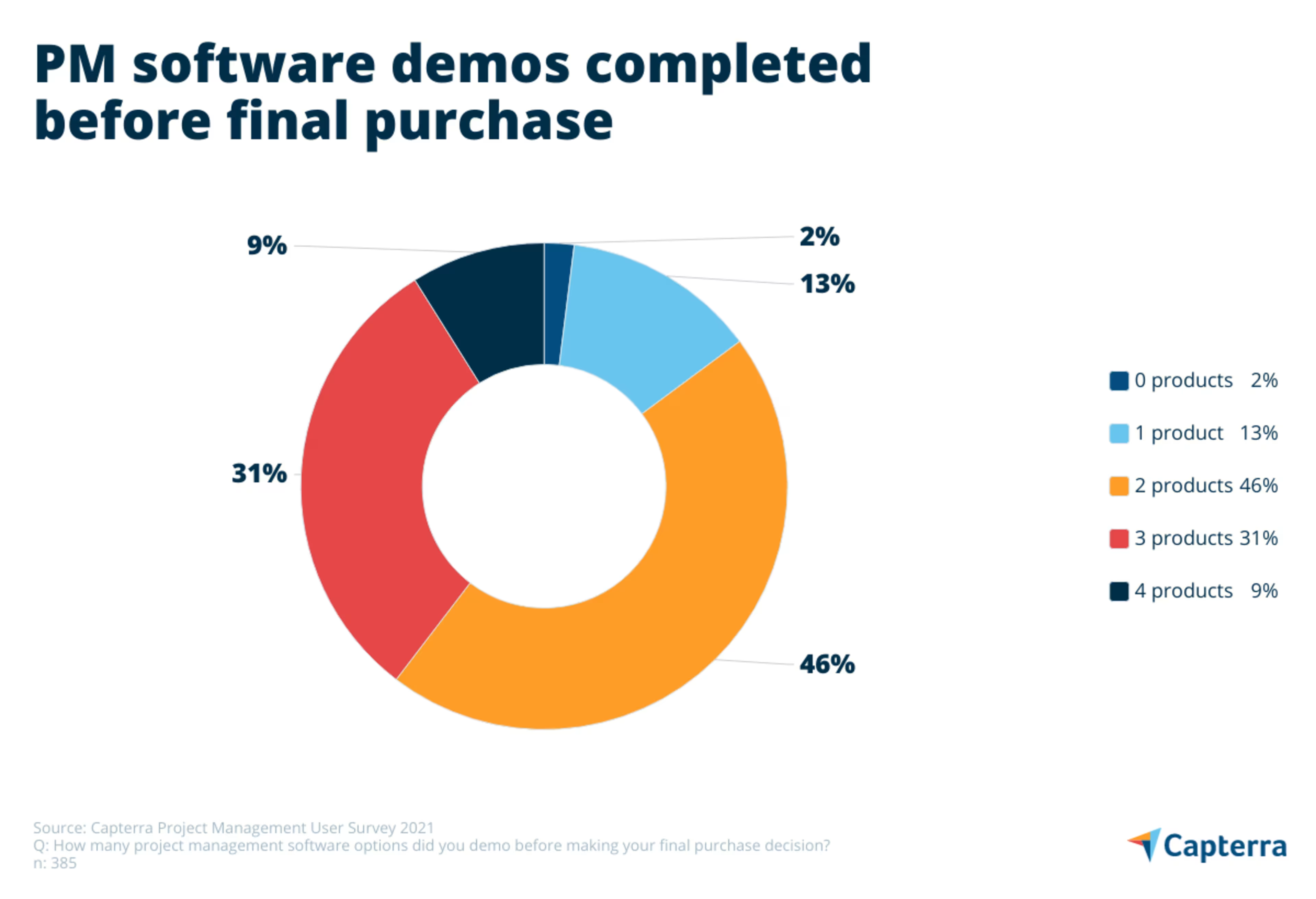
Demos are the best way to evaluate functionality and vet for ease of use before buying, period. The trick is not to let the vendor control the demo, but to provide a detailed overview of your process and workflows ahead of time so they can tailor the demo to your exact needs.
During the demo, score the product (e.g., rank products on a one to five scale) on criteria such as:
How well does the tool meet your requirements?
How many clicks does it take to access important features?
Do colors, labels, and custom fields help or hinder navigation?
Is the tool intuitive for new users? And if not, what support and training options are available?
Of course, don’t go out and demo every product that might be a fit. First, narrow down your options to a shortlist of three to five products and then demo (at a minimum) your top three options.
How are other businesses figuring out how much to budget for project management software?
The short answer: On the whole, users have pretty accurate expectations for how much PM software costs and what they’re willing to spend, whether that’s $3,000 annually, $10,000 annually, or more. We asked respondents what they expected PM software would cost at the start of their search as well as how much they actually spent on the tech (annually, in U.S. dollars). The results show that overall, users have a pretty good idea of what their budget will be before they even get started.
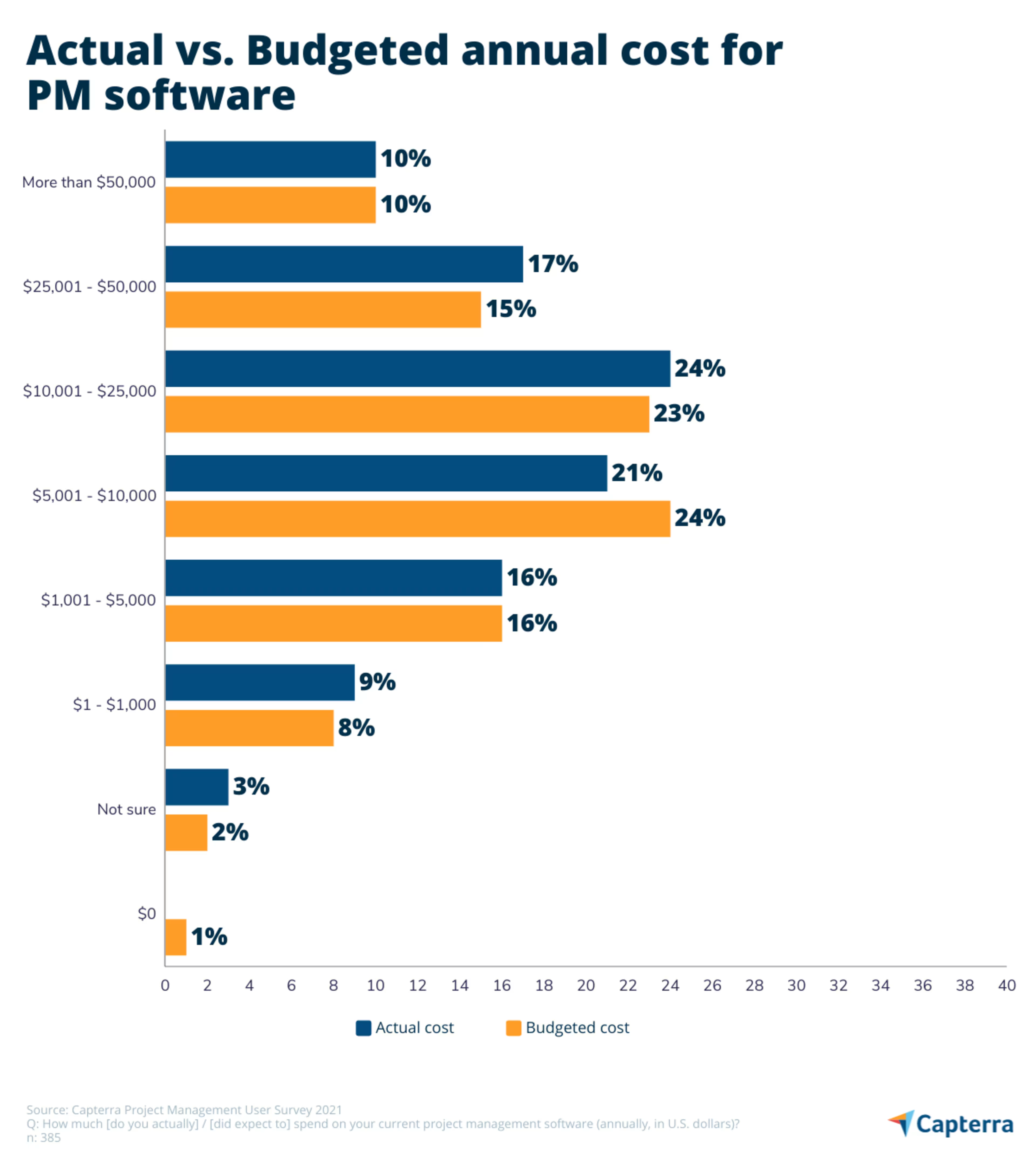
The key to setting accurate price expectations is understanding how many users you need to purchase software licenses for. Here’s a breakdown of how many user licenses our respondents purchased.
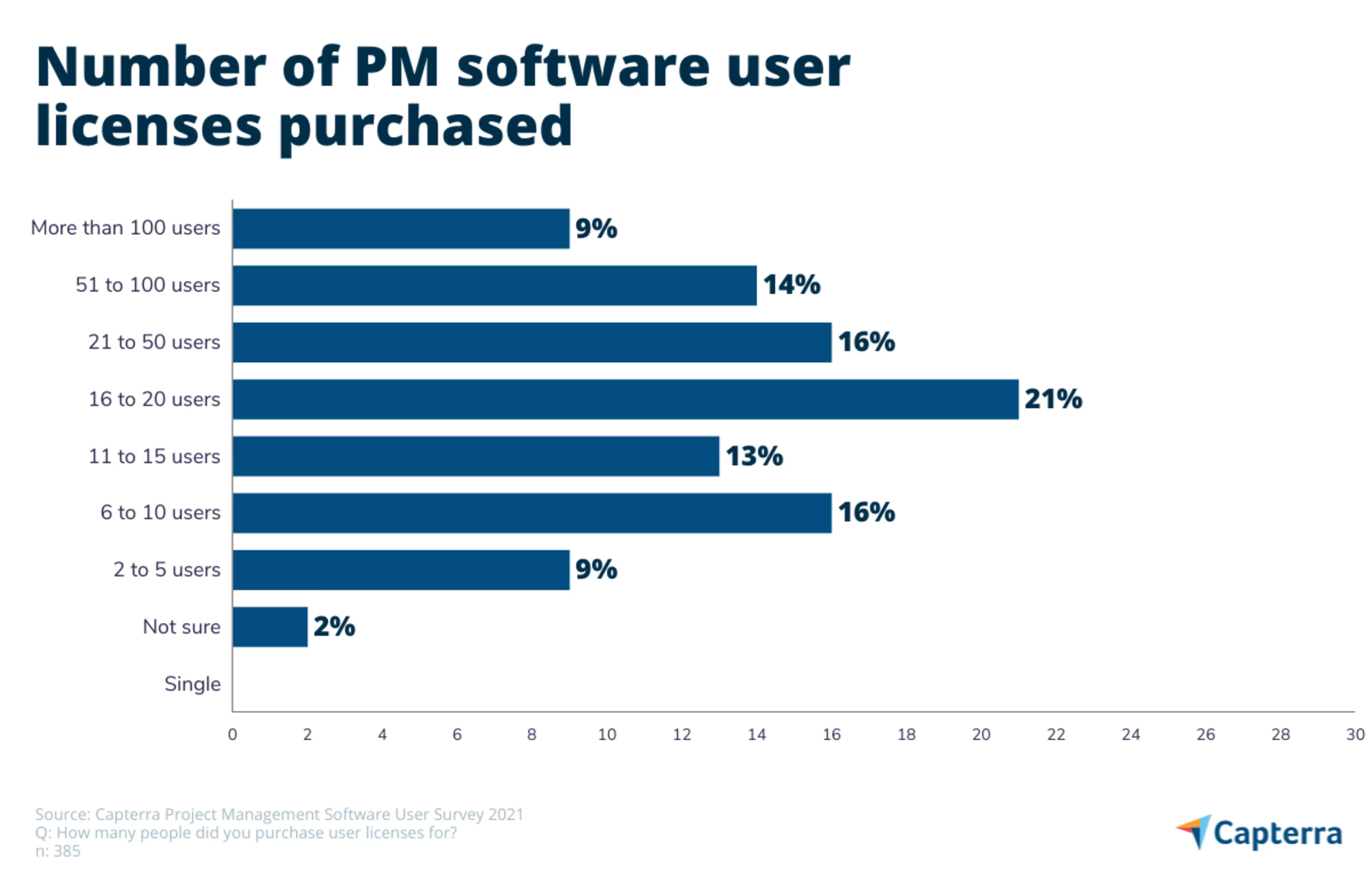
Note: Not all PM software vendors charge per user, but it is a common pricing model. Buying your team of eight each a license will cost vastly different than a large project management office (PMO) of 100+ users.
How long is it taking other companies to get started using the software?
Great question. We asked users how long it took them to find and then implement their PM solutions, and it’s not very long. And they’re also not taking very long to get users up to speed on their new tool:
63% spend less than six months evaluating PM tools
61% spend less than six months implementing the new tool at their company
The key takeaway here is that, provided you set your team up with ample training and onboarding resources, it’s a safe bet that your own PM software implementation will mirror the vast majority of your peers and take less than a year.
What features are my peers prioritizing in project management software?
The short answer: The most-used PM software features are reports/dashboards, document management, and collaboration. Gantt and burndown charts are surprisingly both in the most-ignored and most-desired PM software features lists.
We gave users a list of features and asked them to select whether they have it and use it, whether they have it and don’t use it, and whether they don’t have it but wish they did.
The most-used software features include:
Document management
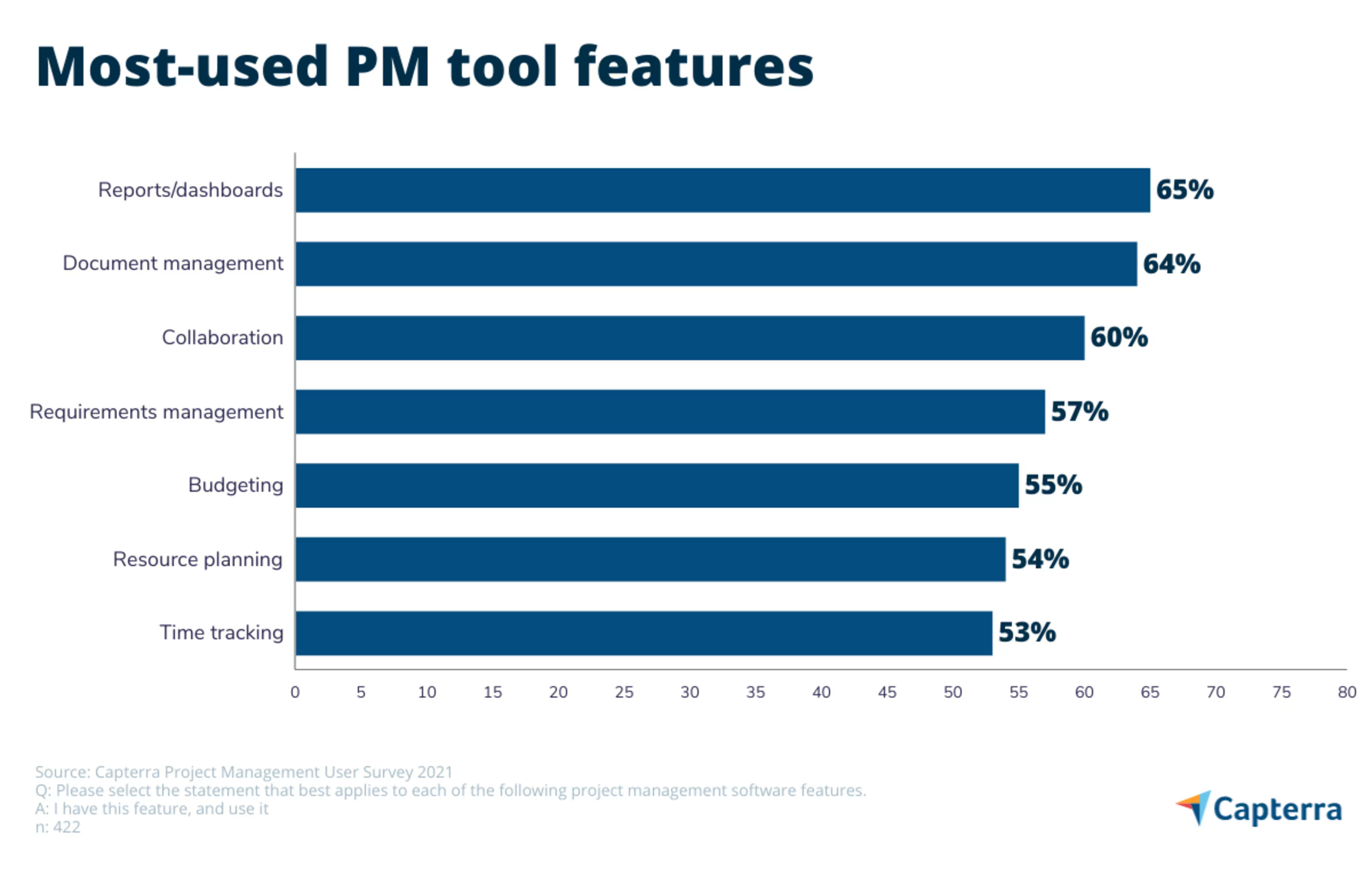
The most-ignored software features by users who have them include:
Velocity charts
Burndown charts
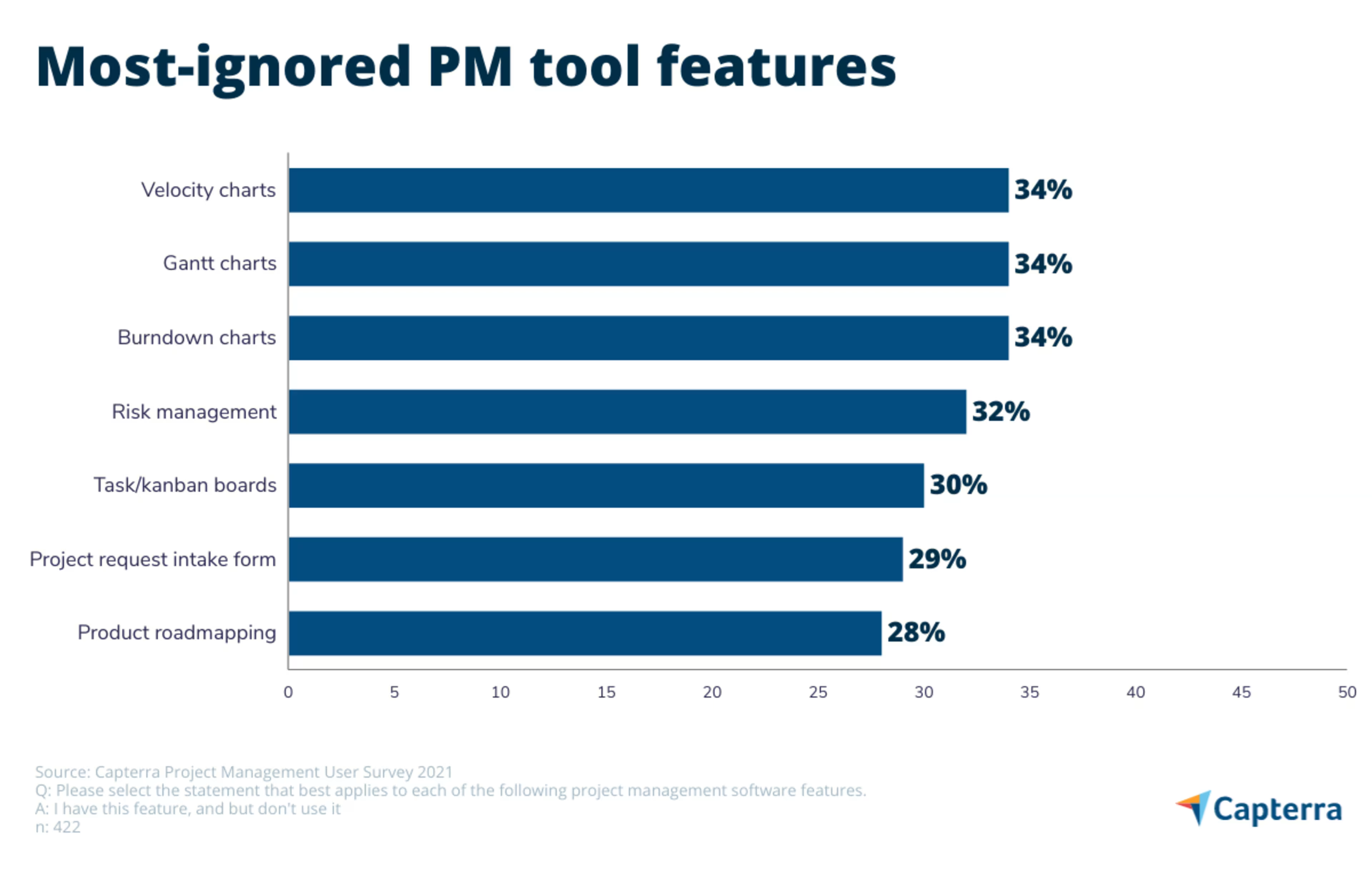
Velocity and burndown charts are features used for Agile and scrum project teams, and with only 17% of PMs using Agile methodologies, it makes sense for them to be ignored by many users. But if you are running Agile or scrum teams, be sure your PM tool offers those two features.
And now, the most-desired software features by those who don’t have them include:
Burndown charts
Automated workflows

Here we see something indicative of mismatched project managers to project management solutions: Gantt charts and burndown charts are in the top for both most-ignored and most-desired. This drives home the point that selecting the right tool for you is key to getting the most out of your investment.
The advice here is pretty simple: Before you start your search, evaluate whether you need a collaborative work management tool, one that supports Agile methodologies, or a more traditional PM solution.
What challenges have my peers experienced, and what can I learn from them?
Glad you asked! To answer this, let’s first start with how businesses are comprising and managing their project teams. Because unfortunately, only a quarter of our surveyed PMs report that their teams are dedicated resources who only focus on their project work.
A majority of teams are cross functional (59%), meaning the team members have “day jobs.” Well, not exactly, but it likely feels like that for some. The team members are in different departments and have other responsibilities outside of the project, but have dedicated time to do project work. Thankfully, the majority of cross-functional teams seem to have a dedicated project manager to lead them, as opposed to 38% of those teams that are led by a team lead who also has their own day job outside of the project.
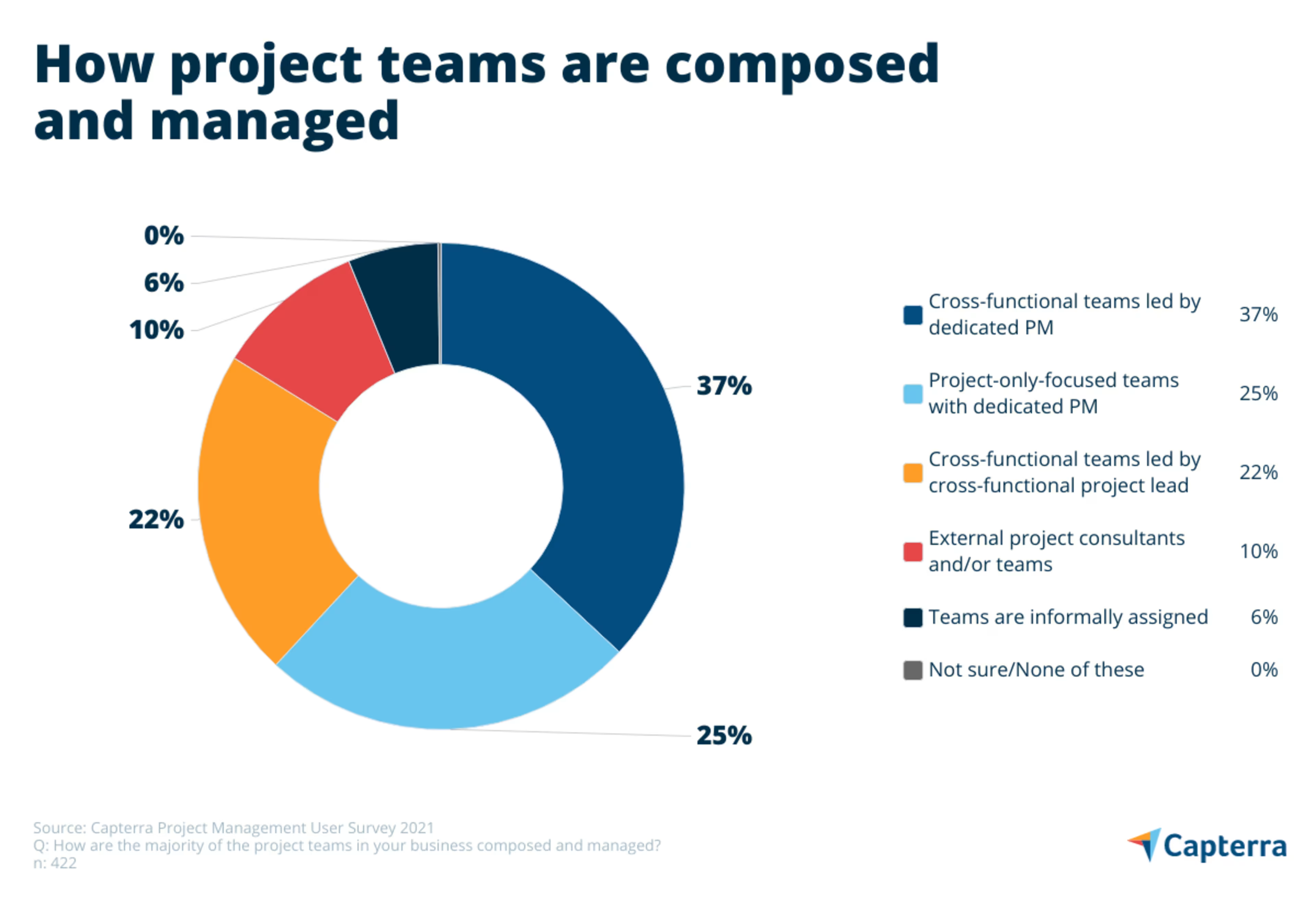
With nearly 60% of project teams being cross-functional, the challenges and how to address those challenges are rooted in this mix and mingle assignment of resources.
A top challenge reported with PM tools is the overall complexity and/or learning curve needed to get the hang of the tools (43%). When teams are cross-functional, they typically are working with multiple systems and a steep learning curve. Having yet another tool can be frustrating and slow down the project. The other top challenges include difficulty integrating the PM tool to other systems (38%) and the lack of personnel/talent to make the most of the tool (36%), which is also rooted in this cross-functional design illustrated by a majority of project teams.
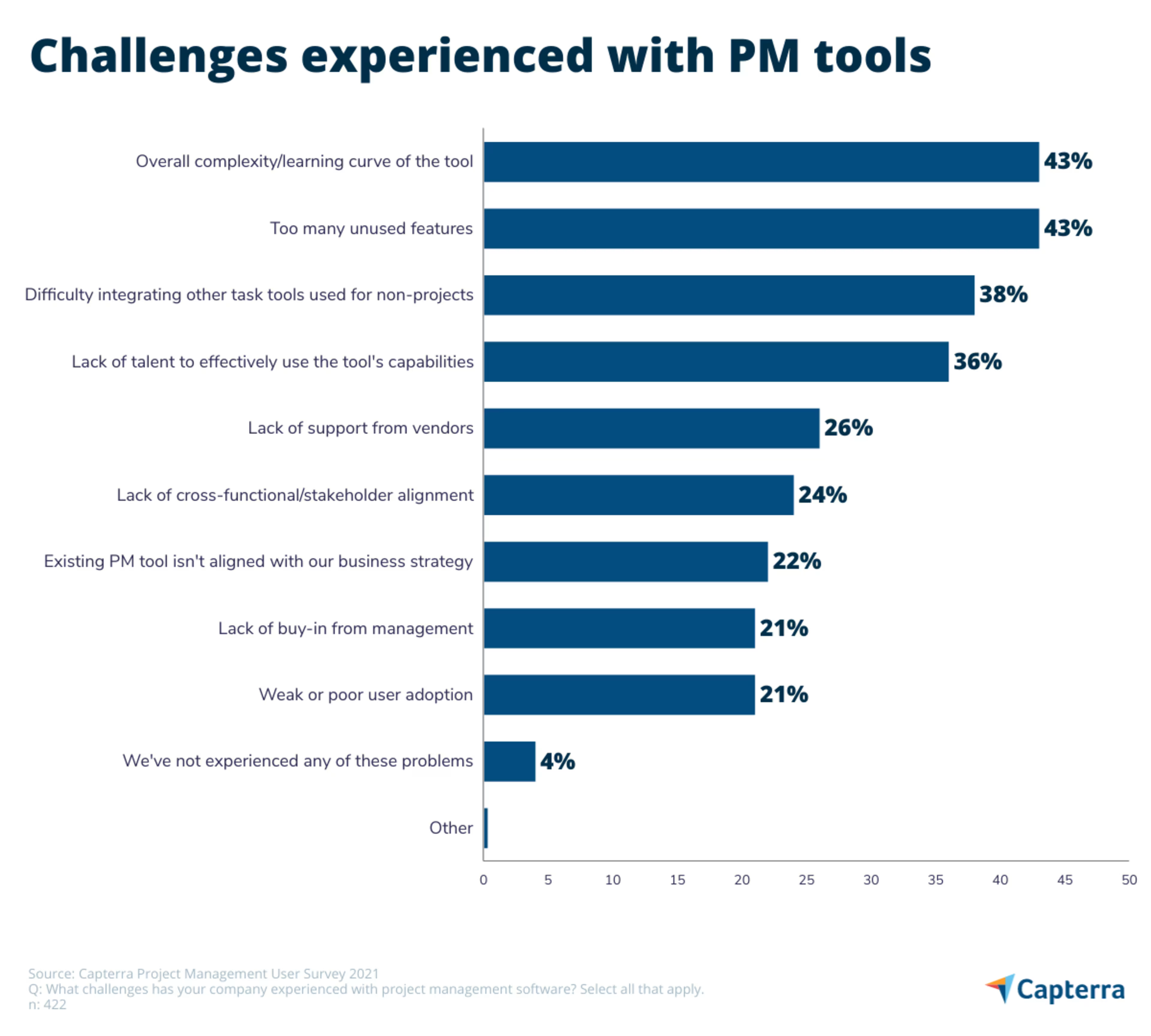
Now let’s get into what your peers have done to improve the effectiveness of their project management solution. Over half of businesses are providing peer-to-peer workshops (52%) to learn the tools. While many of us are still, and maybe forever, working remotely, this is a low-cost, low-risk, and high-reward way for teams to build relationships, learn from each other, and learn the tools.
The second measure being taken complements the first: improving cross-functional collaboration (51%). And it directly helps to address the ongoing theme we see here of cross-functional project teams.
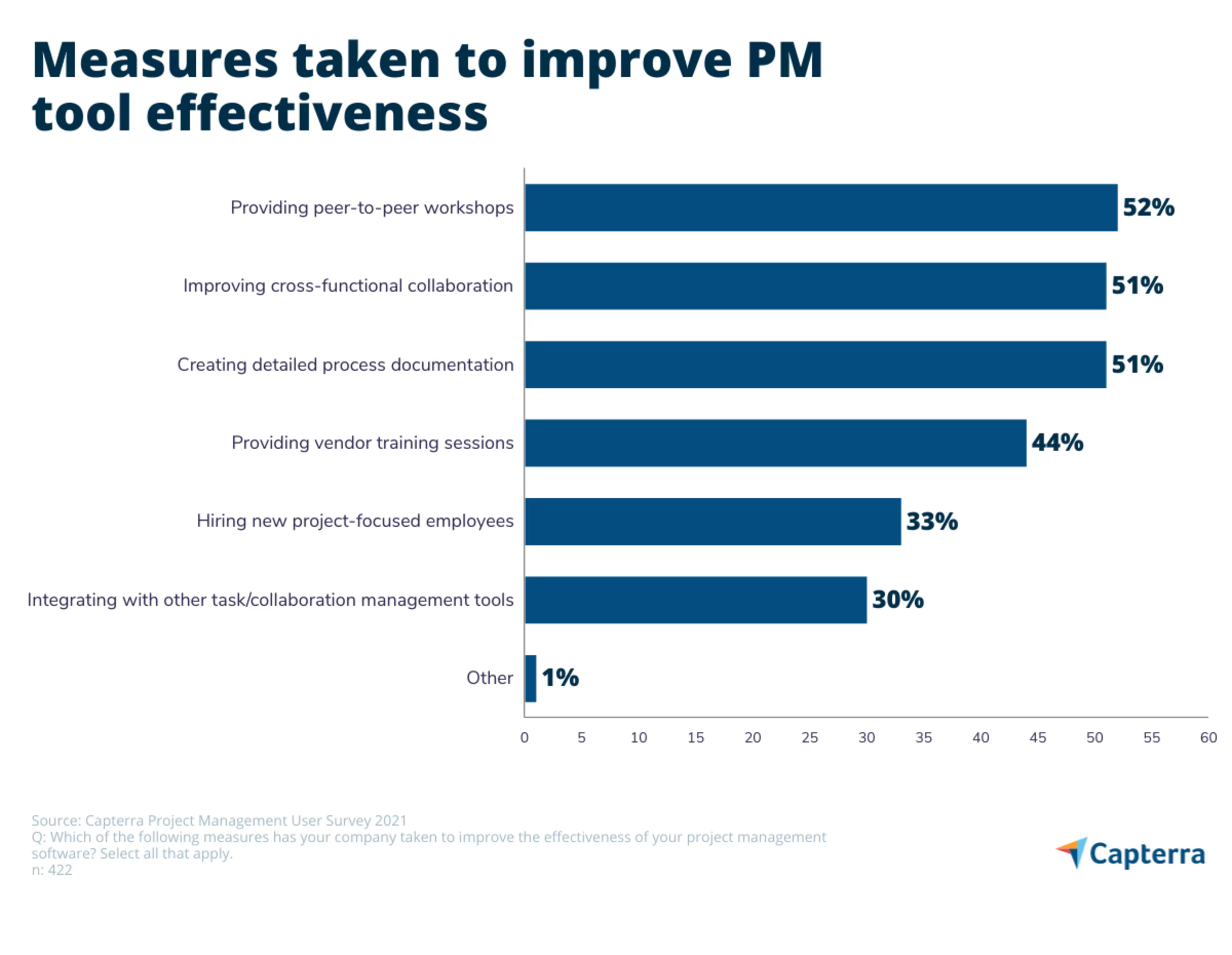
Tying for second place as the most taken measure for improvement is creating detailed process documentation. Having clear, up-to-date how-to guides and videos supports all team members, especially cross-functional ones. Many project team members will only work in a project team part of the year, and taking a break of a few weeks or months from a software system can slow you down unless you have a resource ready to help.
How satisfied are my peers with their PM tool? Do I really need one?
Well, an overwhelming 92% of respondents are somewhat to extremely satisfied with their project management system investment. So odds are good that if you choose the right one, you’ll be wishing you had invested earlier.
We asked those who are dissatisfied why they aren’t satisfied with their current PM tool, and the most-frequently cited reason is because it’s missing necessary features.
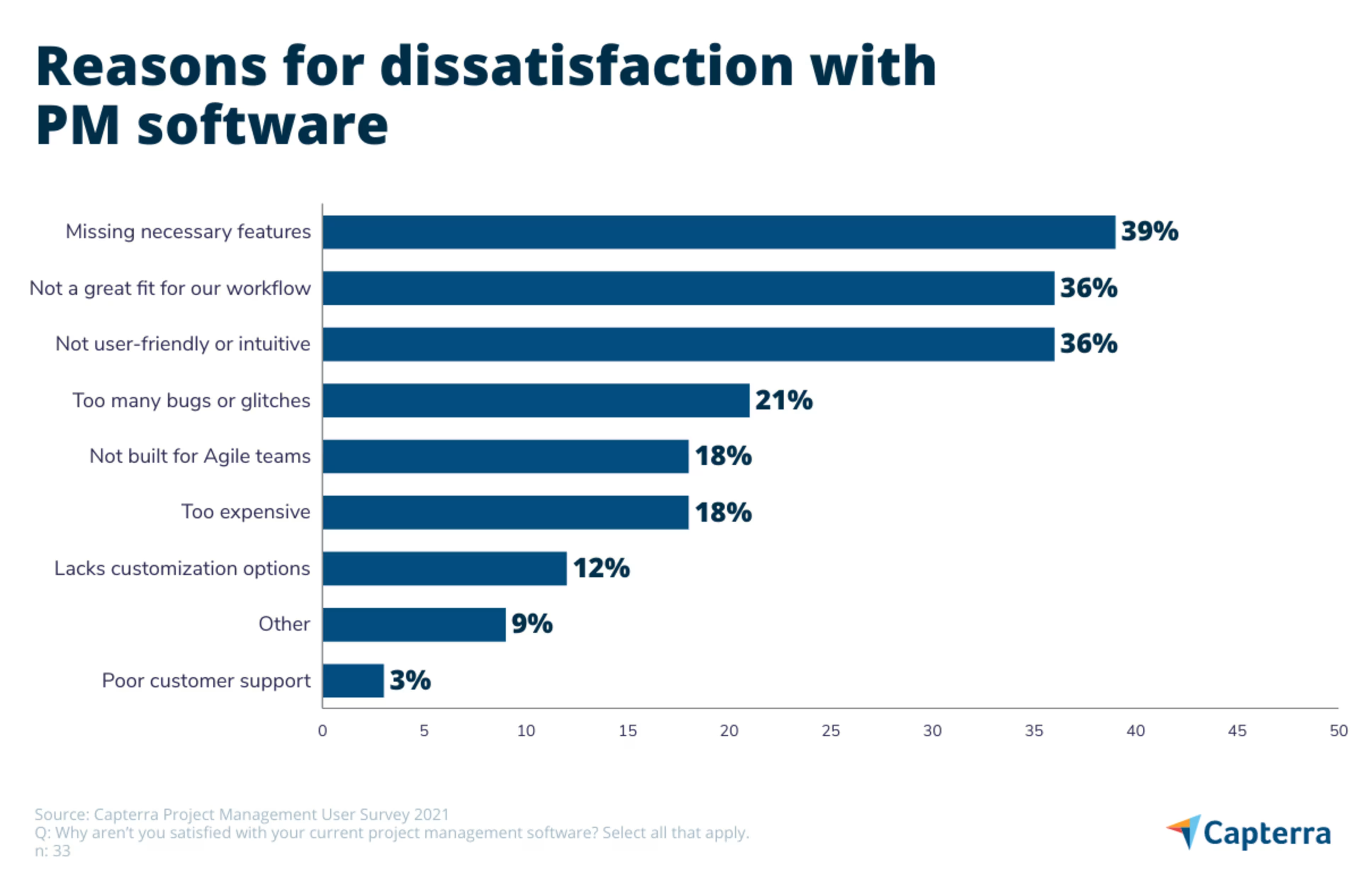
What should I do now?
According to PMI’s 2020 Pulse of the Profession report, 11% of every dollar is wasted as a result of poor project performance. Our findings make it clear that PM software can help you improve project performance, meaning you can reinvest those savings into other areas of your business. So what are you waiting for?
Capterra offers several resources to help you find the products best suited to your specific needs, including:
An interactive PM software directory: Filter products to see those with the exact features your team needs. You can also click through to product profiles and see how your peers have rated tools for factors such as value for money, customer support, and ease of use.
A list of leading free and open source PM tools: If you’re cost conscious like the users in our survey, check out our list of top-rated free PM tools, and see if their features, support, and training meet your needs.
A top features comparison guide: Use this comparison guide to see how the different solutions stack up against each other for the features you need, such as budgeting, Gantt charts, and Agile methodology support.
A project management software pricing guide and cost comparison: Use this guide to compare PM tools by starting price, free trial offers, and pricing model.
Our 2021 Shortlist for project management software: See the top project management tools of 2021 at a glance. We use exclusive data and reviews from people such as you to build our software shortlist, so that you can easily build yours.
